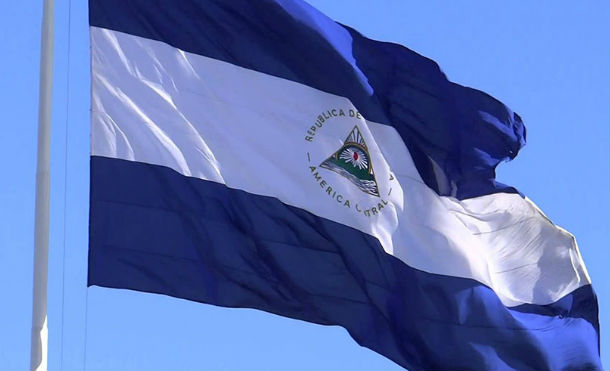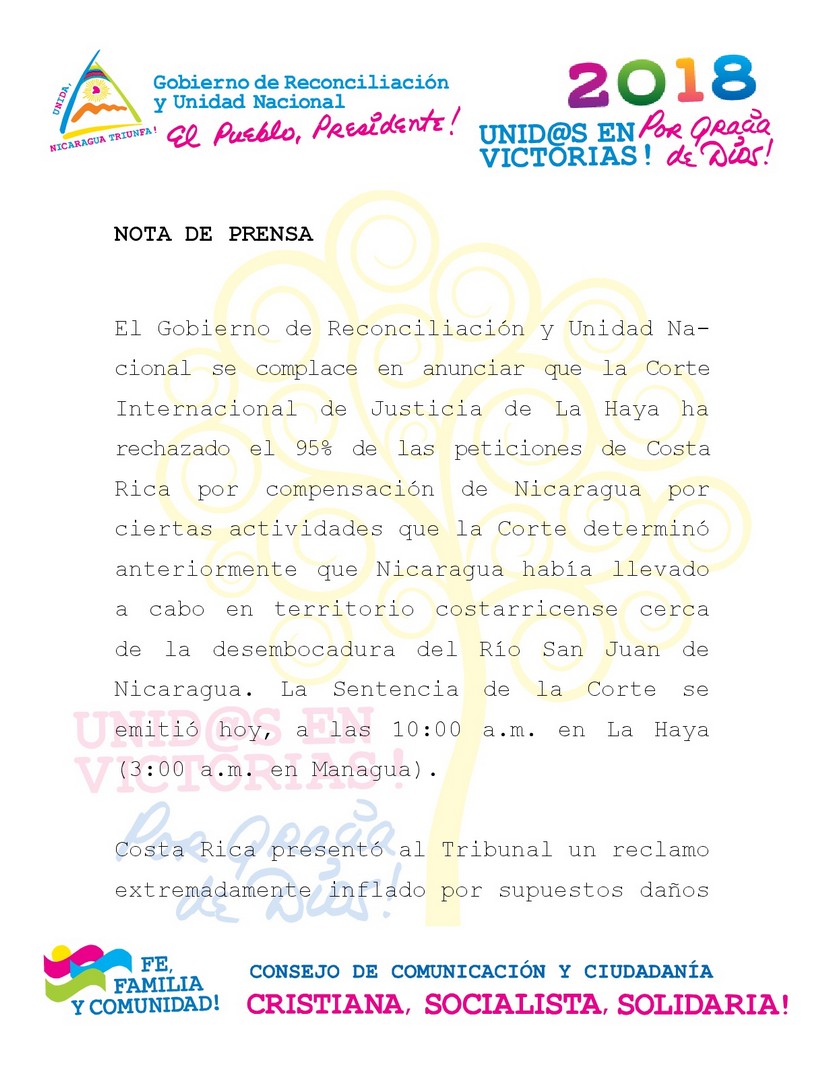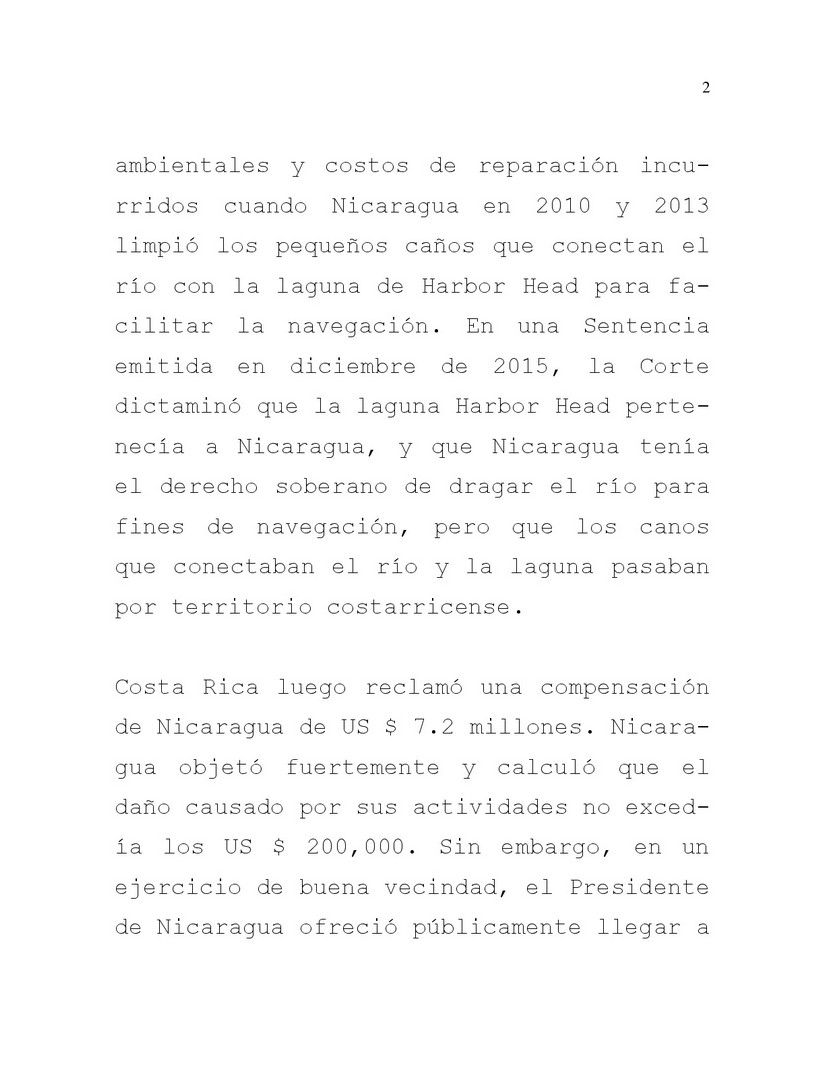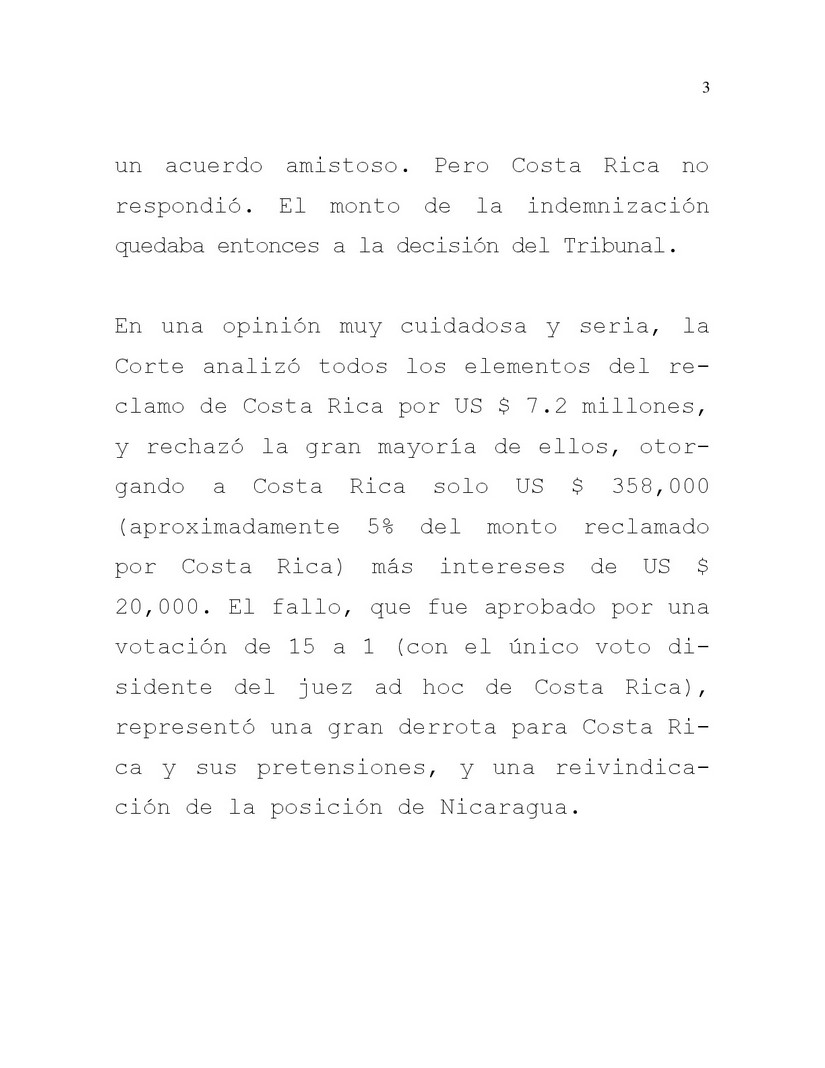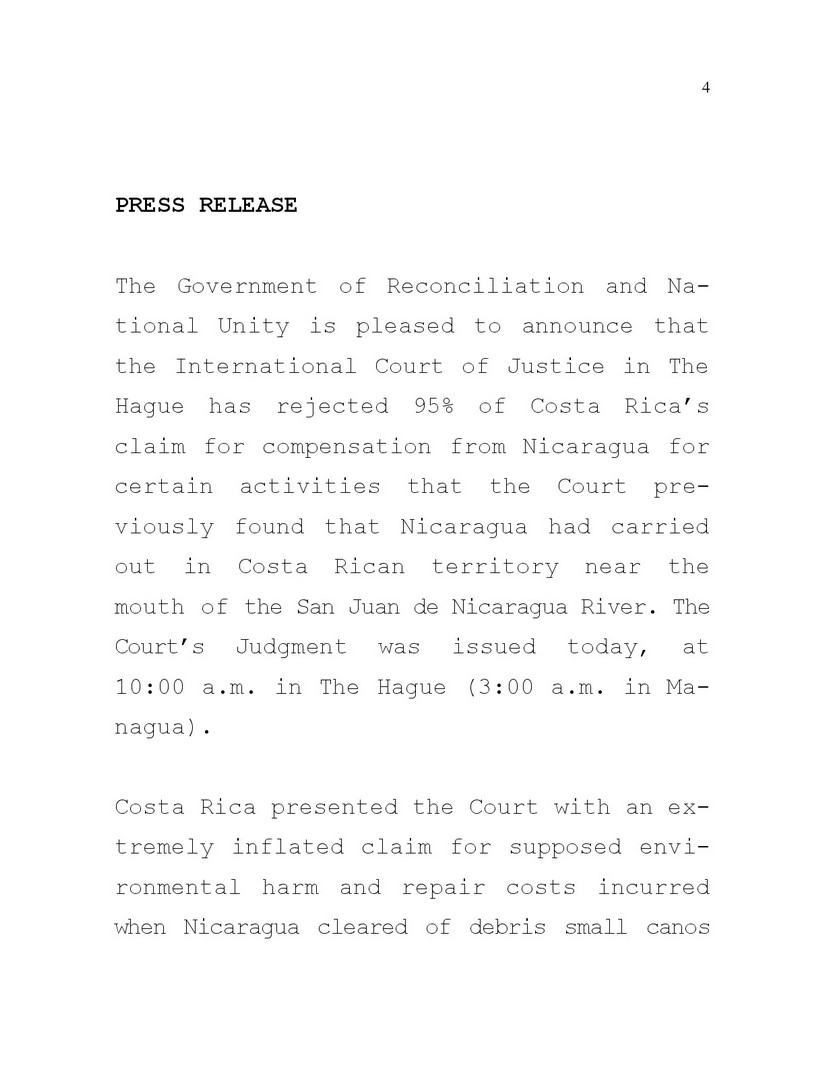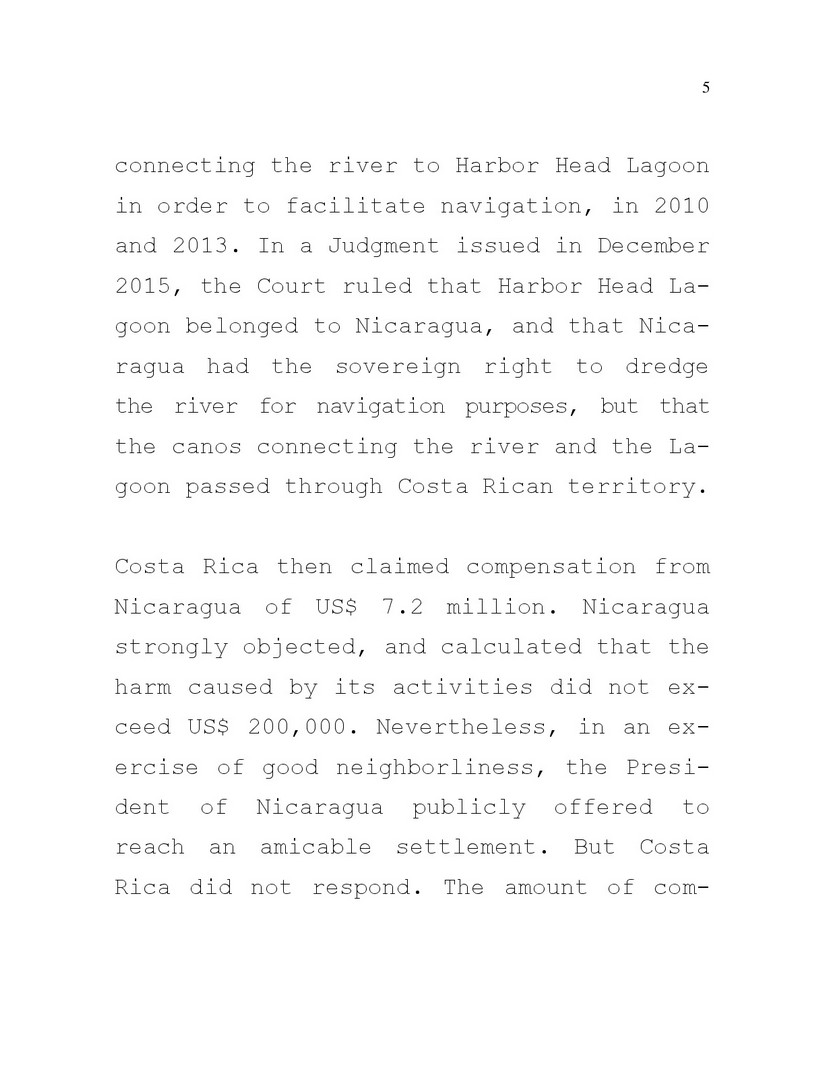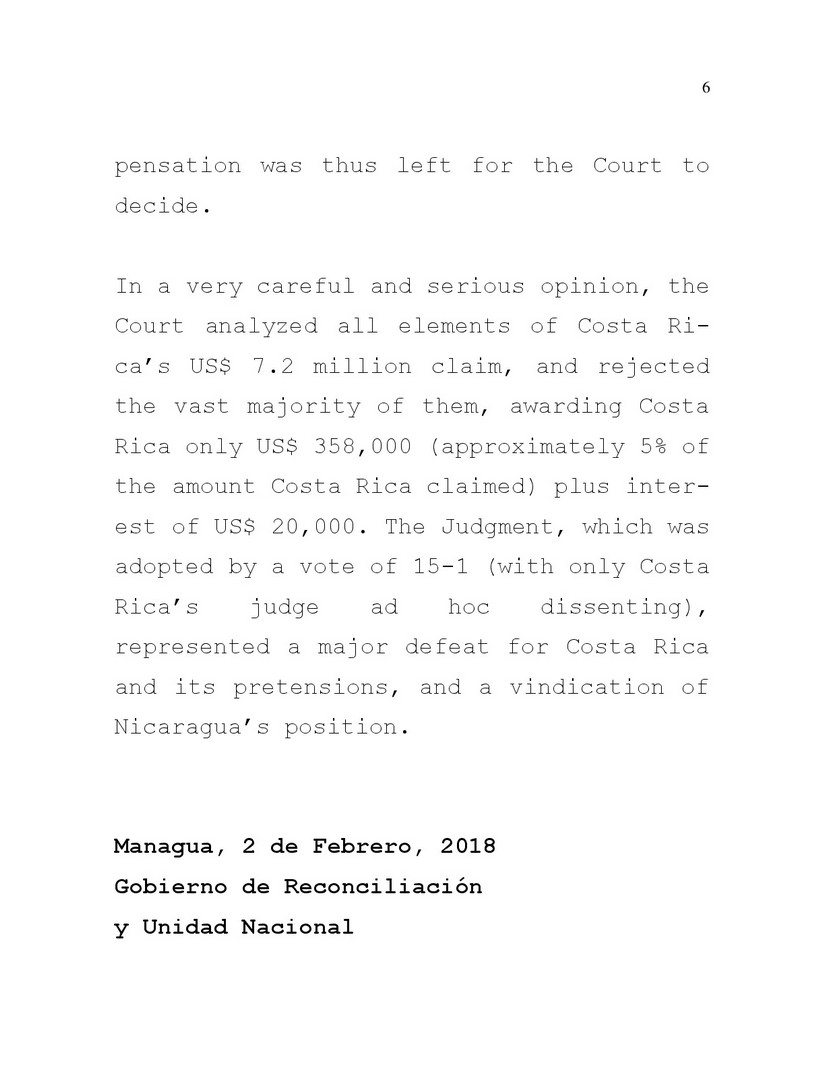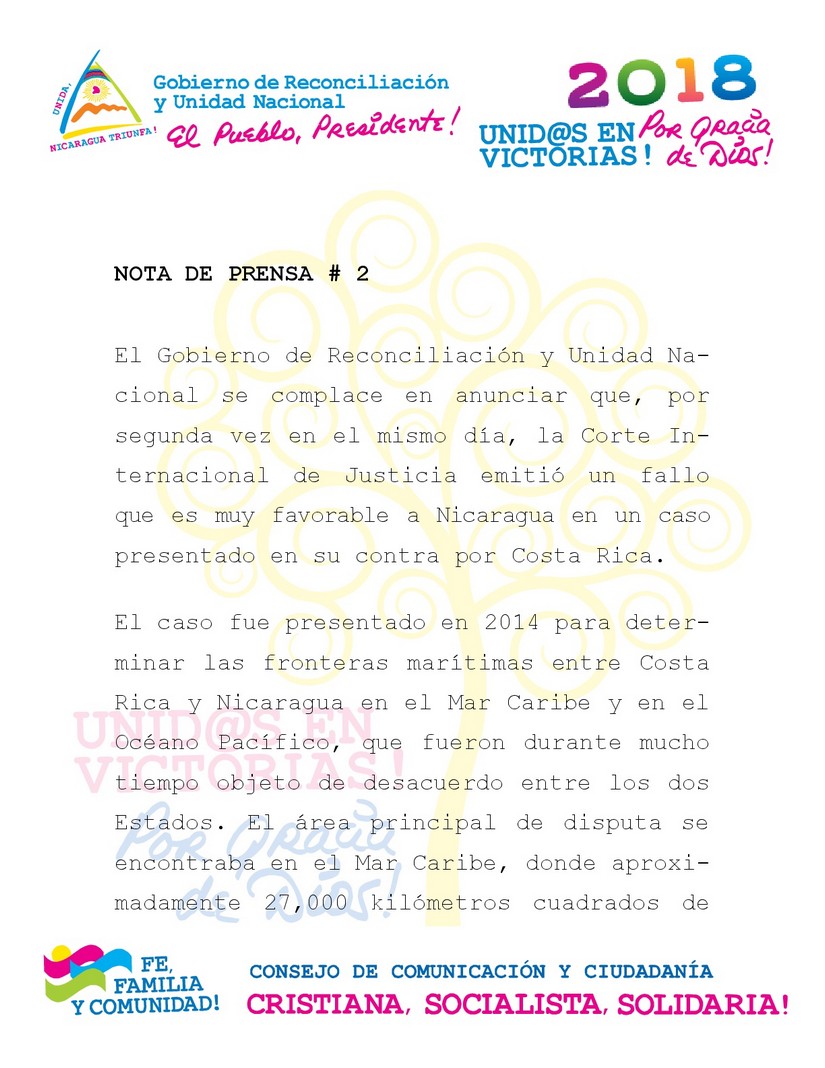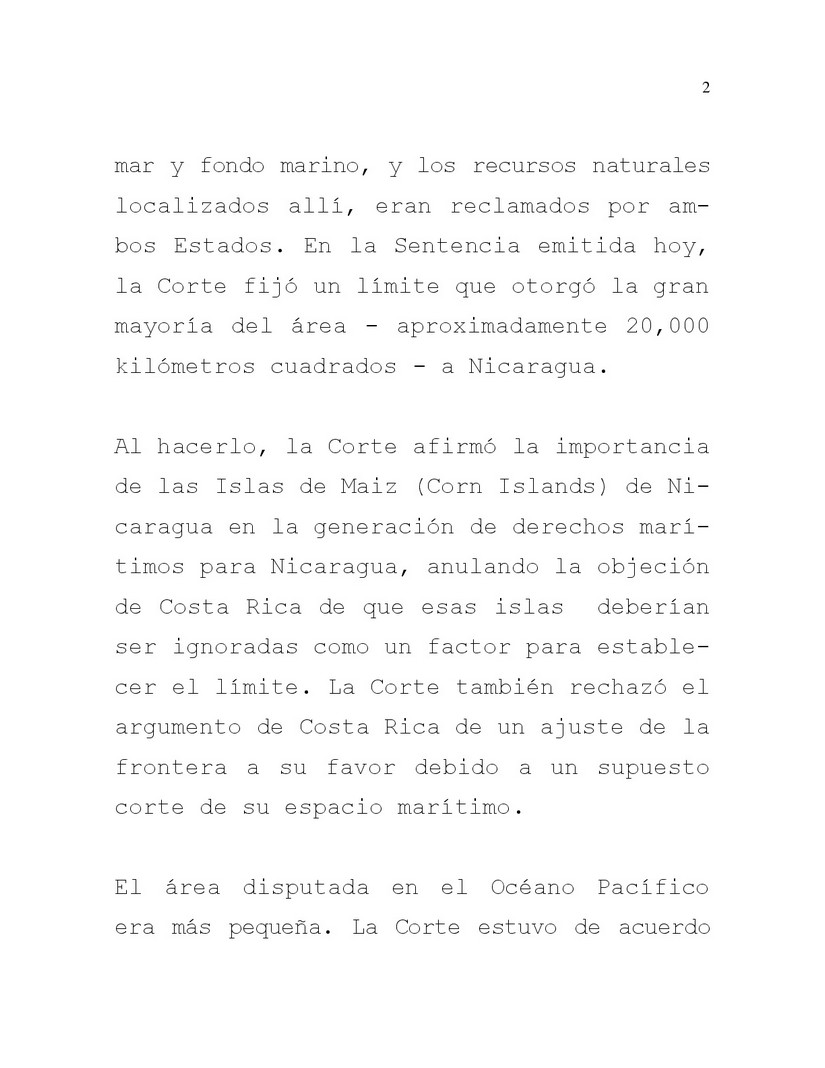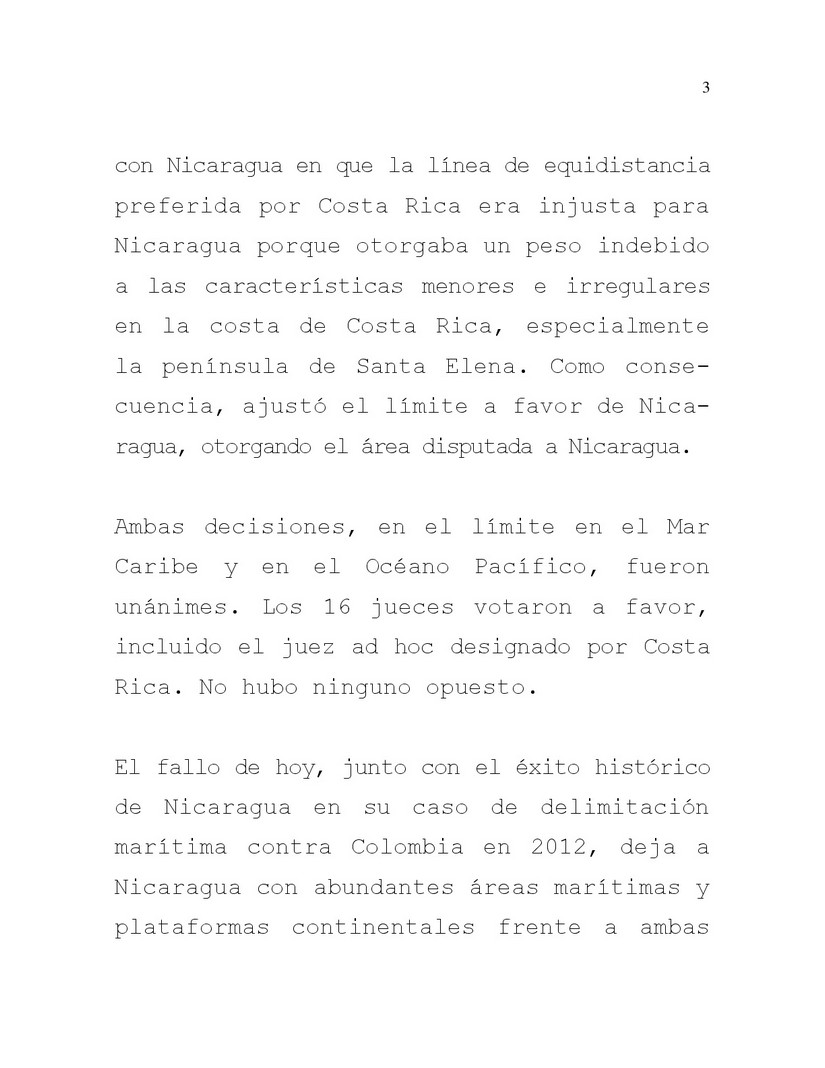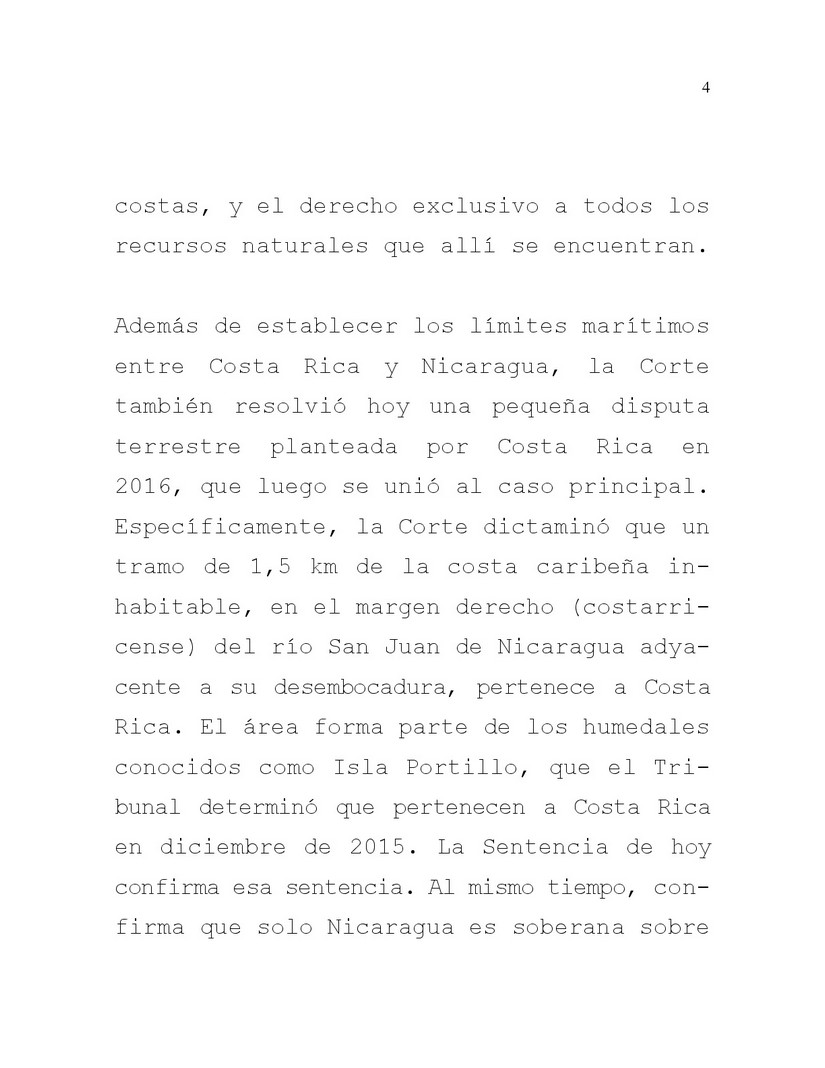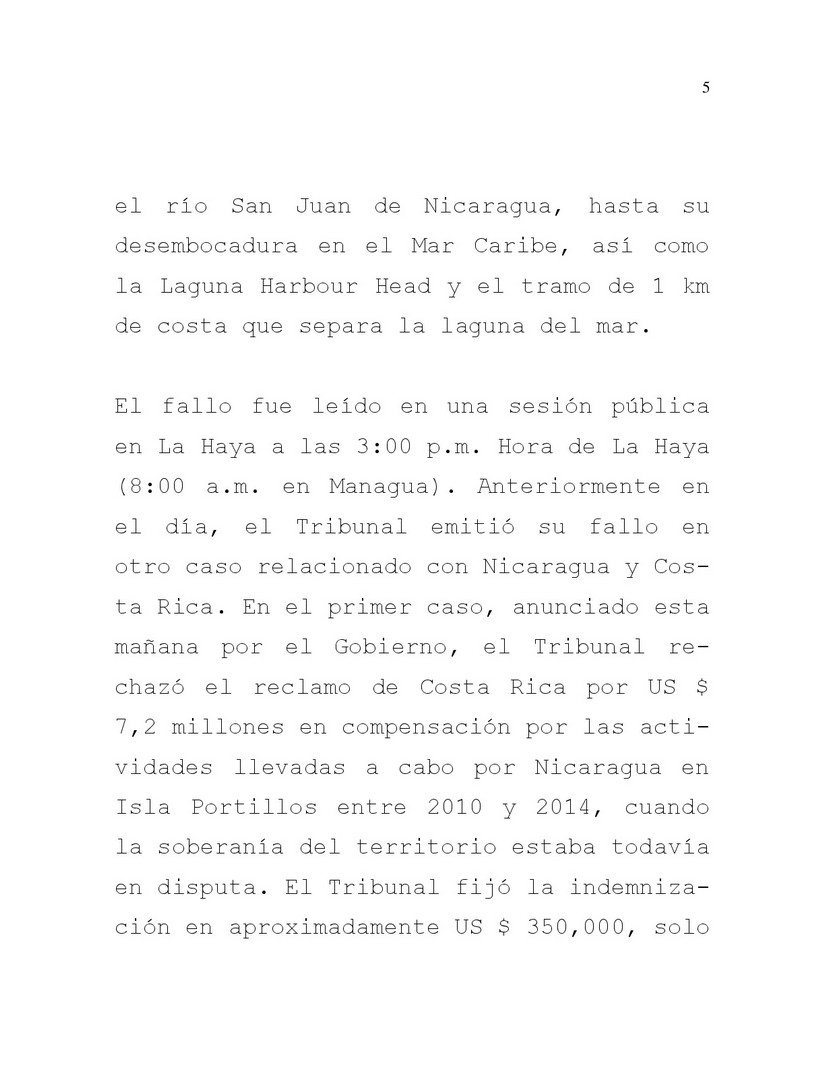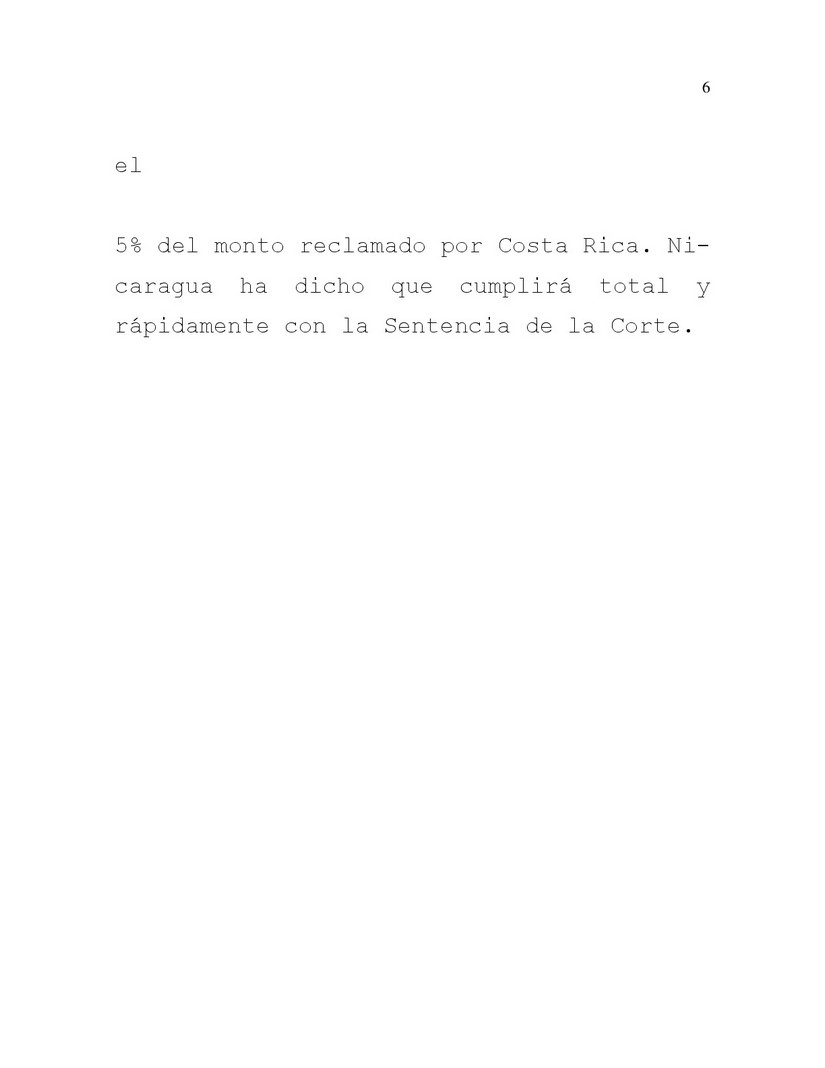El Gobierno de Reconciliación y Unidad Nacional se complace en anunciar que la Corte Internacional de Justicia de La Haya ha rechazado el 95% de las peticiones de Costa Rica por compensación de Nicaragua por ciertas actividades que la Corte determinó anteriormente que Nicaragua había llevado a cabo en territorio costarricense cerca de la desembocadura del Río San Juan de Nicaragua. La Sentencia de la Corte se emitió hoy, a las 10:00 a.m. en La Haya (3:00 a.m. en Managua).
Costa Rica presentó al Tribunal un reclamo extremadamente inflado por supuestos daños ambientales y costos de reparación incurridos cuando Nicaragua en 2010 y 2013 limpió los pequeños caños que conectan el río con la laguna de Harbor Head para facilitar la navegación. En una Sentencia emitida en diciembre de 2015, la Corte dictaminó que la laguna Harbor Head pertenecía a Nicaragua, y que Nicaragua tenía el derecho soberano de dragar el río para fines de navegación, pero que los caños que conectaban el río y la laguna pasaban por territorio costarricense.
Costa Rica luego reclamó una compensación de Nicaragua de US $ 7.2 millones. Nicaragua objetó fuertemente y calculó que el daño causado por sus actividades no excedía los US $ 200,000. Sin embargo, en un ejercicio de buena vecindad, el Presidente de Nicaragua ofreció públicamente llegar a un acuerdo amistoso. Pero Costa Rica no respondió. El monto de la indemnización quedaba entonces a la decisión del Tribunal.
En una opinión muy cuidadosa y seria, la Corte analizó todos los elementos del reclamo de Costa Rica por US $ 7.2 millones, y rechazó la gran mayoría de ellos, otorgando a Costa Rica solo US $ 358,000 (aproximadamente 5% del monto reclamado por Costa Rica) más intereses de US $ 20,000. El fallo, que fue aprobado por una votación de 15 a 1 (con el único voto disidente del juez ad hoc de Costa Rica), representó una gran derrota para Costa Rica y sus pretensiones, y una reivindicación de la posición de Nicaragua.
PRESS RELEASE
The Government of Reconciliation and National Unity is pleased to announce that the International Court of Justice in The Hague has rejected 95% of Costa Rica’s claim for compensation from Nicaragua for certain activities that the Court previously found that Nicaragua had carried out in Costa Rican territory near the mouth of the San Juan de Nicaragua River. The Court’s Judgment was issued today, at 10:00 a.m. in The Hague (3:00 a.m. in Managua).
Costa Rica presented the Court with an extremely inflated claim for supposed environmental harm and repair costs incurred when Nicaragua cleared of debris small canos connecting the river to Harbor Head Lagoon in order to facilitate navigation, in 2010 and 2013. In a Judgment issued in December 2015, the Court ruled that Harbor Head Lagoon belonged to Nicaragua, and that Nicaragua had the sovereign right to dredge the river for navigation purposes, but that the canos connecting the river and the Lagoon passed through Costa Rican territory.
Costa Rica then claimed compensation from Nicaragua of US$ 7.2 million. Nicaragua strongly objected, and calculated that the harm caused by its activities did not exceed US$ 200,000. Nevertheless, in an exercise of good neighborliness, the President of Nicaragua publicly offered to reach an amicable settlement. But Costa Rica did not respond. The amount of com-pensation was thus left for the Court to decide.
In a very careful and serious opinion, the Court analyzed all elements of Costa Rica’s US$ 7.2 million claim, and rejected the vast majority of them, awarding Costa Rica only US$ 358,000 (approximately 5% of the amount Costa Rica claimed) plus interest of US$ 20,000. The Judgment, which was adopted by a vote of 15-1 (with only Costa Rica’s judge ad hoc dissenting), represented a major defeat for Costa Rica and its pretensions, and a vindication of Nicaragua’s position.
NOTA DE PRENSA #2
El Gobierno de Reconciliación y Unidad Nacional se complace en anunciar que, por segunda vez en el mismo día, la Corte Internacional de Justicia emitió un fallo que es muy favorable a Nicaragua en un caso presentado en su contra por Costa Rica.
El caso fue presentado en 2014 para determinar las fronteras marítimas entre Costa Rica y Nicaragua en el Mar Caribe y en el Océano Pacífico, que fueron durante mucho tiempo objeto de desacuerdo entre los dos Estados. El área principal de disputa se encontraba en el Mar Caribe, donde aproximadamente 27,000 kilómetros cuadrados de mar y fondo marino, y los recursos naturales localizados allí, eran reclamados por ambos Estados. En la Sentencia emitida hoy, la Corte fijó un límite que otorgó la gran mayoría del área – aproximadamente 20,000 kilómetros cuadrados – a Nicaragua.
Al hacerlo, la Corte afirmó la importancia de las Islas de Maiz (Corn Islands) de Nicaragua en la generación de derechos marítimos para Nicaragua, anulando la objeción de Costa Rica de que esas islas deberían ser ignoradas como un factor para establecer el límite. La Corte también rechazó el argumento de Costa Rica de un ajuste de la frontera a su favor debido a un supuesto corte de su espacio marítimo.
El área disputada en el Océano Pacífico era más pequeña. La Corte estuvo de acuerdo con Nicaragua en que la línea de equidistancia preferida por Costa Rica era injusta para Nicaragua porque otorgaba un peso indebido a las características menores e irregulares en la costa de Costa Rica, especialmente la península de Santa Elena. Como consecuencia, ajustó el límite a favor de Nicaragua, otorgando el área disputada a Nicaragua.
Ambas decisiones, en el límite en el Mar Caribe y en el Océano Pacífico, fueron unánimes. Los 16 jueces votaron a favor, incluido el juez ad hoc designado por Costa Rica. No hubo ninguno opuesto.
El fallo de hoy, junto con el éxito histórico de Nicaragua en su caso de delimitación marítima contra Colombia en 2012, deja a Nicaragua con abundantes áreas marítimas y plataformas continentales frente a ambas costas, y el derecho exclusivo a todos los recursos naturales que allí se encuentran.
Además de establecer los límites marítimos entre Costa Rica y Nicaragua, la Corte también resolvió hoy una pequeña disputa terrestre planteada por Costa Rica en 2016, que luego se unió al caso principal. Específicamente, la Corte dictaminó que un tramo de 1,5 km de la costa caribeña inhabitable, en el margen derecho (costarricense) del río San Juan de Nicaragua adyacente a su desembocadura, pertenece a Costa Rica. El área forma parte de los humedales conocidos como Isla Portillo, que el Tribunal determinó que pertenecen a Costa Rica en diciembre de 2015. La Sentencia de hoy confirma esa sentencia. Al mismo tiempo, confirma que solo Nicaragua es soberana sobre el río San Juan de Nicaragua, hasta su desembocadura en el Mar Caribe, así como la Laguna Harbour Head y el tramo de 1 km de costa que separa la laguna del mar.
El fallo fue leído en una sesión pública en La Haya a las 3:00 p.m. Hora de La Haya (8:00 a.m. en Managua). Anteriormente en el día, el Tribunal emitió su fallo en otro caso relacionado con Nicaragua y Costa Rica. En el primer caso, anunciado esta mañana por el Gobierno, el Tribunal rechazó el reclamo de Costa Rica por US $ 7,2 millones en compensación por las acti-vidades llevadas a cabo por Nicaragua en Isla Portillos entre 2010 y 2014, cuando la soberanía del territorio estaba todavía en disputa. El Tribunal fijó la indemnización en aproximadamente US $ 350,000, solo el 5% del monto reclamado por Costa Rica. Nicaragua ha dicho que cumplirá total y rápidamente con la Sentencia de la Corte.
PRESS RELEASE # 2
The Government of Reconciliation and National Unity is pleased to announce that, for the second time in the same day, the International Court of Justice has issued a Judgment that is very favorable to Nicaragua in a case brought against it by Costa Rica.
The case was brought in 2014 to determine the maritime boundaries between Costa Rica and Nicaragua in the Caribbean Sea and in the Pacific Ocean, which were long the subject of disagreement between the two States. The principal area of dispute was in the Caribbean Sea, where approximately 27,000 square kilometers of sea and seabed, and the natural resources located there, were claimed by both States. In the Judgment issued today, the Court fixed a boundary that awarded the vast majority of the area – approximately 20,000 square ki-lometers – to Nicaragua.
In so doing, the Court affirmed the significance of Nicaragua’s Corn Islands in generating maritime entitlements for Nicaragua, overruling Costa Rica’s objection that the Corn Islands should be ignored as a factor in establishing the boundary. The Court also rejected Costa Rica’s argument for an adjustment of the boundary in its favor due to an alleged cutoff of its maritime space.
The disputed area in the Pacific Ocean was smaller. The Court agreed with Nicaragua that the equidistance line favored by Costa Rica was unfair to Nicaragua because it gave undue weight to minor and irregular features on Costa Rica’s coast, especially the Santa Elena Peninsula. As a consequence, it adjusted the boundary in Nicaragua’s favor, awarding the disputed area to Nicaragua.
Both decisions, on the boundary in the Caribbean Sea and in the Pacific Ocean, were unanimous. All 16 judges voted in favor, including the judge ad hoc appointed by Costa Rica. There were none opposed.
Today’s Judgment, coupled with Nicaragua’s historic success in its maritime delimitation case against Colombia in 2012, leave Nicaragua with abundant maritime areas and continental shelves off both of its coasts, and exclusive entitlement to all natural resources that are present there.
In addition to settling the maritime boundaries between Costa Rica and Nicaragua, the Court today also resolved a small land dispute raised by Costa Rica in 2016, which was then joined to the main case. Specifically, the Court ruled that a 1.5 km stretch of uninhabitable Caribbean coast, on the right (Costa Rican) bank of the San Juan de Nicaragua River adjacent to its mouth, belongs to Costa Rica. The area forms part of the wetlands known as Isla Portillo, which the Court determined to belong to Costa Rica in December 2015. The Judgment today confirms that ruling. At the same time, it confirms that Nicaragua alone is sovereign over the San Juan de Nicaragua River, all the way to its mouth at the Caribbean Sea, as well as Harbor Head Lagoon and the 1 km stretch of coast that separates the Lagoon from the Sea.
The Judgment was read in a public session in The Hague at 3:00 p.m. Hague time (8:00 a.m.in Managua). Earlier in the day, the Courtissued its Judgment in another case involvingNicaragua and Costa Rica. In the first case,with was the subject of an earlier announcement by the Government, the Court rejected Costa Rica’s claim for US$ 7.2 million in compensation for activities carried out by Nicaragua in Isla Portillos between 2010 and 2014, when title to the territory was still in dispute. Instead, the Court fixed the compensation at approximately US$ 350,000 – only 5% of the amount claimed by Costa Rica. Nicaragua has said it will fully and promptly comply with the Court’s Judgment.
Managua, 2 de Febrero, 2018
Gobierno de Reconciliación
y Unidad Nacional
Esta entrada fue modificada por última vez el 2 de febrero de 2018 a las 10:44 AM

